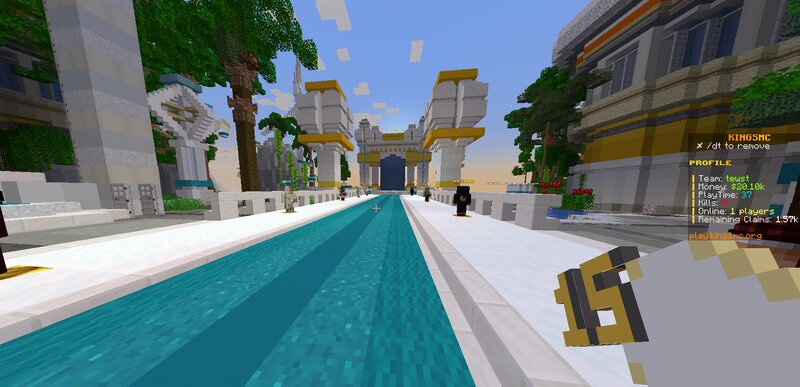Come mine, sell, buy and most importantly become Minecraft rich!!
Mine away make a base have fun be safe enjoy
Play as much as you want when ever you want and do what you want!
Apply for admin moderator etc etc
Dont read what is below
Introduced the idea of using pairs of word-like units extracted in an unsupervised way to provide a noisy top-down signal for representation learning from raw (untranscribed) speech. The learned representations capture phonetic distinctions better than standard (un-learned) features or those learned purely bottom-up. Others later applied this idea cross-lingually (Yuan et al., Interspeech 2016) and used it as a baseline for other approaches (He, Wang, and Livescu, ICLR 2017). This paper focussed on engineering applications, but led to later funding from NSF and ESRC to explore the idea introduced here as a model of perceptual learning in infants.Introduced the idea of using pairs of word-like units extracted in an unsupervised way to provide a noisy top-down signal for representation learning from raw (untranscribed) speech. The learned representations capture phonetic distinctions better than standard (un-learned) features or those learned purely bottom-up. Others later applied this idea cross-lingually (Yuan et al., Interspeech 2016) and used it as a baseline for other approaches (He, Wang, and Livescu, ICLR 2017). This paper focussed on engineering applications, but led to later funding from NSF and ESRC to explore the idea introduced here as a model of perceptual learning in infants.Introduced the idea of using pairs of word-like units extracted in an unsupervised way to provide a noisy top-down signal for representation learning from raw (untranscribed) speech. The learned representations capture phonetic distinctions better than standard (un-learned) features or those learned purely bottom-up. Others later applied this idea cross-lingually (Yuan et al., Interspeech 2016) and used it as a baseline for other approaches (He, Wang, and Livescu, ICLR 2017). This paper focussed on engineering applications, but led to later funding from NSF and ESRC to explore the idea introduced here as a model of perceptual learning in infants.Introduced the idea of using pairs of word-like units extracted in an unsupervised way to provide a noisy top-down signal for representation learning from raw (untranscribed) speech. The learned representations capture phonetic distinctions better than standard (un-learned) features or those learned purely bottom-up. Others later applied this idea cross-lingually (Yuan et al., Interspeech 2016) and used it as a baseline for other approaches (He, Wang, and Livescu, ICLR 2017). This paper focussed on engineering applications, but led to later funding from NSF and ESRC to explore the idea introduced here as a model of perceptual learning in infants.Introduced the idea of using pairs of word-like units extracted in an unsupervised way to provide a noisy top-down signal for representation learning from raw (untranscribed) speech. The learned representations capture phonetic distinctions better than standard (un-learned) features or those learned purely bottom-up. Others later applied this idea cross-lingually (Yuan et al., Interspeech 2016) and used it as a baseline for other approaches (He, Wang, and Livescu, ICLR 2017). This paper focussed on engineering applications, but led to later funding from NSF and ESRC to explore the idea introduced here as a model of perceptual learning in infants.Introduced the idea of using pairs of word-like units extracted in an unsupervised way to provide a noisy top-down signal for representation learning from raw (untranscribed) speech. The learned representations capture phonetic distinctions better than standard (un-learned) features or those learned purely bottom-up. Others later applied this idea cross-lingually (Yuan et al., Interspeech 2016) and used it as a baseline for other approaches (He, Wang, and Livescu, ICLR 2017). This paper focussed on engineering applications, but led to later funding from NSF and ESRC to explore the idea introduced here as a model of perceptual learning in infants.Introduced the idea of using pairs of word-like units extracted in an unsupervised way to provide a noisy top-down signal for representation learning from raw (untranscribed) speech. The learned representations capture phonetic distinctions better than standard (un-learned) features or those learned purely bottom-up. Others later applied this idea cross-lingually (Yuan et al., Interspeech 2016) and used it as a baseline for other approaches (He, Wang, and Livescu, ICLR 2017). This paper focussed on engineering applications, but led to later funding from NSF and ESRC to explore the idea introduced here as a model of perceptual learning in infants.Introduced the idea of using pairs of word-like units extracted in an unsupervised way to provide a noisy top-down signal for representation learning from raw (untranscribed) speech. The learned representations capture phonetic distinctions better than standard (un-learned) features or those learned purely bottom-up. Others later applied this idea cross-lingually (Yuan et al., Interspeech 2016) and used it as a baseline for other approaches (He, Wang, and Livescu, ICLR 2017). This paper focussed on engineering applications, but led to later funding from NSF and ESRC to explore the idea introduced here as a model of perceptual learning in infants.Introduced the idea of using pairs of word-like units extracted in an unsupervised way to provide a noisy top-down signal for representation learning from raw (untranscribed) speech. The learned representations capture phonetic distinctions better than standard (un-learned) features or those learned purely bottom-up. Others later applied this idea cross-lingually (Yuan et al., Interspeech 2016) and used it as a baseline for other approaches (He, Wang, and Livescu, ICLR 2017). This paper focussed on engineering applications, but led to later funding from NSF and ESRC to explore the idea introduced here as a model of perceptual learning in infants.
Hype1mines.minehut.gg




















